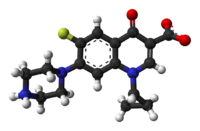环丙沙星
 | |
 | |
| 临床资料 | |
|---|---|
| 商品名 | Ciloxan, Cipro, Neofloxin, others |
| AHFS/Drugs.com | Monograph |
| MedlinePlus | a688016 |
| 核准状况 |
|
| 怀孕分级 |
|
| 给药途径 | 口服、静脉注射、外用药物(耳滴剂、眼药水) |
| ATC码 | |
| 法律规范状态 | |
| 法律规范 |
|
| 药物动力学数据 | |
| 生物利用度 | 70%[1] |
| 血浆蛋白结合率 | 30%[1] |
| 药物代谢 | 肝脏(CYP1A2及其他) |
| 生物半衰期 | 3.5 小时[1] |
| 排泄途径 | 肾 |
| 识别信息 | |
| |
| CAS号 | 85721-33-1 |
| PubChem CID | |
| DrugBank | |
| ChemSpider | |
| UNII | |
| KEGG | |
| ChEBI | |
| ChEMBL | |
| NIAID ChemDB | |
| CompTox Dashboard (EPA) | |
| ECHA InfoCard | 100.123.026 |
| 化学信息 | |
| 化学式 | C17H18FN3O3 |
| 摩尔质量 | 331.35 g·mol−1 |
| 3D模型(JSmol) | |
| |
| |
环丙沙星(Ciprofloxacin)是第二代氟喹诺酮类化合广效抗生素[2],可对抗多种病原菌[2]。治疗范围包含骨骼感染、关节感染、腹部感染,以及特定几种感染性肠胃炎、呼吸道感染、皮肤感染、伤寒,以及泌尿道感染等等[2]。本品亦可配合其他抗生素进行治疗[2],可经口服或静脉注射给药[2]。
常见副作用包含恶心、呕吐、腹泻,以及皮肤红疹[2],还会导致永久性肌腱炎,增加肌腱断裂风险,且重症肌无力患者服用后肌肉无力的症状可能恶化[2]。严重的有可能使人身体神经衰弱、残疾、甚至终生难以恢复。副作用发生的几率较头孢菌素高[3]。动物实验表明妊娠期间用药可能具有些微风险[4],孕妇服用有少数胎儿产生问题[4]。哺乳期间用药目前显示安全[2]。本品透过抑制细菌的DNA旋转酶达到杀菌的效果[2][5][6]。
环丙沙星于1987年首次发现[7],并列名于世界卫生组织基本药物标准清单之中,为基础公卫体系必备药物之一[8]。本品属于通用名药物,价格不贵[2][9]。发展中国家每剂批发价约介于0.03至0.13美金之间[10],美国每剂则约0.40美金[2]。
适应症
在美国此药被批准用于给成人治疗以下已检验出的病菌感染:
- 泌尿道感染感染(推荐作为首选抗生素)[11]
- 女性急性膀胱炎并发症
- 慢性细菌性前列腺炎(推荐作为首选抗生素)
- 下呼吸道感染(不推荐作为首选抗生素)[12][13]
- 急性鼻窦炎(不推荐作为首选抗生素)[14]
- 皮肤和皮肤结构感染
- 骨和关节感染
- 感染性腹泻
- 伤寒(肠溶热)(伤寒杆菌导致)
- 单纯性颈部及尿道淋病(淋球菌导致) - 但一些地区因为抗药性而不再有效(亚洲国家,美国(包括夏威夷),加拿大,和苏格兰)。在美国不再推荐用于这类治疗。[15][16][17][18]
以及结合其他具体药物:
副作用
注意:氟喹诺酮类抗生素有可能导致肌腱炎,韧带断裂,软骨和软组织疼痛。这种状况经常是在停药很久之后发生,比如几周或几个月之后发生,届时病人和医生都很难把这种副作用和该药物关联起来,这造成了大量的副作用的发生没有被计入医学统计,从而降低了医生和病人对该类药物副作用的重视程度。这被为数不少的副作用受害者认为是一个普遍存在,却没有引起重视的医疗问题乃至社会问题。受害者甚至都不知道自己的长期“神秘”疼痛是来自于氟喹诺酮类抗生素。
2013年8月15日, 美国食品药品监督管理局(FDA)要求更新所有氟喹诺酮类抗生素的药品说明书和用药指南,以更好的描述周围神经病变这一严重副作用。由氟喹诺酮类药品引起的严重神经损害可能在使用这些药物不久后发生,且可能不可逆转。周围神经病变仅发生于喹诺酮类药物的口服或注射制剂。外用氟喹诺酮类制剂(滴耳剂或滴眼剂)与该风险不相关。如果患者出现周围神经病变症状,应停用氟喹诺酮类药物,换用其他非喹诺酮类抗生素,除非继续使用氟喹诺酮类治疗的获益大于风险。周围神经病变是一种发生于手臂或腿部的神经病变。症状包括疼痛、灼热感、刺痛、麻木、无力,或轻触感、痛感或温度感发生改变。周围神经病变可发生于氟喹诺酮类治疗期间的任何时间,且在药物停用后可持续数月至数年,或为永久性改变。
目前,美国食品药物监督管理局(FDA)规定,所有氟喹诺酮类抗生素的产品包装上都必须加注“黑盒子”警告(“black box”是FDA所发出的最严厉的警告),提醒医生该类药物可能导致病人患肌腱炎或者肌腱断裂、周围神经病变及恶化重症肌无力等。
FDA网站上2016年7月公布了氟喹诺酮类抗生素的一系列的副作用,如手臂或腿部有“如坐针毡”的麻木或刺痛感、肌肉无力、肌肉疼痛、关节疼痛、关节肿胀、焦虑、忧郁、幻觉、自杀倾向、意识混乱等,肌腱、肌肉、关节、周边神经、中枢神经损伤。
FDA还建议,“沙星”类抗生素要作为抗生素的最后选择,医疗人员如果有其他治疗选择下尽量避免使用全身性“沙星”类抗生素。
呼应FDA的新规定,加拿大卫生部今年1月底发布声明,呼应了FDA对氟喹诺酮类抗生素的副作用的警告,并加上可能导致视网膜脱落的警告。
美国疾病控制中心(Centers for Disease Control and Prevention)多年前就对滥用氟喹诺酮类抗生素表示顾虑,他们指出医生在开药时没有考虑到是否适合不同的患者,不必要地采用了“一刀切”的治疗方案。
药物互相作用
药物安全委员会和美国食品药品监督管理局警告:当非类固醇消炎药与喹诺酮类药物合并使用,中枢神经系统的不良反应包括癫痫发作风险可能会增加[20][21]。这种相互作用的机制可能涉及协同增强GABA神经传递的拮抗作用[22][23]。
别名
它的别名有:环丙氟哌酸、奔克、丙氟哌酸、环丙沙星、健美灵、适普灵、特美力、悉复欢、悉普宁、西普乐、特美力、奎诺仙、环福星、全复康、速博新、Ciprofloxacin、Bay-O-9867、 CFLX、Ciproxin、Cifran、Temaril及CPFX等。[24]
参考资料
- ^ 1.0 1.1 1.2 Zhanel, G. G.; Fontaine, S; Adam, H; Schurek, K; Mayer, M; Noreddin, A. M.; Gin, A. S.; Rubinstein, E; Hoban, D. J. A Review of New Fluoroquinolones : Focus on their Use in Respiratory Tract Infections. Treatments in respiratory medicine. 2006, 5 (6): 437–65. PMID 17154673.
- ^ 2.00 2.01 2.02 2.03 2.04 2.05 2.06 2.07 2.08 2.09 2.10 Ciprofloxacin Hydrochloride. The American Society of Health-System Pharmacists. [2015-08-23]. (原始内容存档于2017-08-13).
- ^ Heidelbaugh, J. J.; Holmstrom, H. The perils of prescribing fluoroquinolones. The Journal of family practice. 2013, 62 (4): 191–7 [2017-07-01]. PMID 23570031. (原始内容存档于2021-08-28).
- ^ 4.0 4.1 Prescribing medicines in pregnancy database. Australian Government. 2015-08-23 [2017-07-01]. (原始内容存档于2014-04-08).
- ^ Ball, P. Quinolone generations: Natural history or natural selection?. Journal of Antimicrobial Chemotherapy. 2000, 46: 17–24. PMID 10997595. doi:10.1093/oxfordjournals.jac.a020889.
- ^ Oliphant, C. M.; Green, G. M. Quinolones: A comprehensive review. American family physician. 2002, 65 (3): 455–64 [2017-07-01]. PMID 11858629. (原始内容存档于2021-08-28).
- ^ Oxford Handbook of Infectious Diseases and Microbiology. OUP Oxford. 2009: 56 [2017-07-01]. ISBN 978-0-19-103962-1. (原始内容存档于2015-11-24).
- ^ WHO Model List of Essential Medicines (19th List) (PDF). World Health Organization. April 2015 [2016-12-08]. (原始内容存档 (PDF)于2016-12-13).
- ^ Hamilton, Richard J. Tarascon pharmacopoeia 15. Jones & Bartlett Publishers. 2014: 85 [2017-07-01]. ISBN 978-1-284-05671-6. (原始内容存档于2016-03-05).
- ^ Ciprofloxacin. International Drug Price Indicator Guide. [2015-08-24].[永久失效链接]
- ^ Fluroquinolone Drug Class Review. Oregon State University College of Pharmacy. 2002 [2009-09-04]. (原始内容存档于2009年2月21日).
- ^ Alexander, Richard B; Propert, Kathleen J; Schaeffer, Anthony J; Landis, J. Richard; Nickel, J. Curtis; O'Leary, Michael P; Pontari, Michel A; McNaughton-collins, Mary; Shoskes, Daniel A; Comiter, Craig V; Datta, Nand S; Fowler, Jackson E; Nadler, Robert B; Zeitlin, Scott I; Knauss, Jill S; Wang, Yanlin; Kusek, John W; Nyberg, Leroy M; Litwin, Mark S; Network*, and the Chronic Prostatitis Collaborative Research. Ciprofloxacin or Tamsulosin in Men with Chronic Prostatitis/Chronic Pelvic Pain Syndrome: A Randomized, Double-Blind Trial. Annals of Internal Medicine. 2004-10-19, 141 (8): 581 [2010-03-22]. ISSN 0003-4819. PMID 15492337. (原始内容存档于2009-08-15).
did not substantially reduce symptoms in men with long-standing CP/CPPS who had at least moderate symptoms.
- ^ J. Dimitrakov; J. Tchitalov, T. Zlatanov, D. Dikov. A Prospective, Randomized, Double-Blind, Placebo-Controlled Study Of Antibiotics For The Treatment Of Category Iiib Chronic Pelvic Pain Syndrome In Men. Third International Chronic Prostatitis Network. [2009-09-04]. (原始内容存档于2010-06-19).
- ^ Karageorgopoulos, DE.; Giannopoulou, KP.; Grammatikos, AP.; Dimopoulos, G.; Falagas, ME. Fluoroquinolones compared with beta-lactam antibiotics for the treatment of acute bacterial sinusitis: a meta-analysis of randomized controlled trials.. CMAJ. March 2008, 178 (7): 845–54 [2010-03-22]. PMC 2267830
 . PMID 18362380. doi:10.1503/cmaj.071157. (原始内容存档于2010-02-06).
. PMID 18362380. doi:10.1503/cmaj.071157. (原始内容存档于2010-02-06).
- ^ (World Health Organization (WHO) Western Pacific Region Gonococcal Antimicrobial Susceptibility Programme (GASP) Report- 2000. Commun Dis Intell 2001; 25:274-277).
- ^ DEPARTMENT OF HEALTH AND HUMAN SERVICES; Centers for Disease Control and Prevention. Gonococcal Isolate Surveillance Project (GISP) Annual Report - 2003 (PDF). USA: Center for Disease Controlo. November 2004 [2009-08-31]. (原始内容存档 (PDF)于2009-04-24).
- ^ Hugh Young. Ciprofloxacin resistant gonorrhoea: the situation in Scotland and implications for therapy (PDF). SCIEH Weekly Report - SCOTTISH CENTRE FOR INFECTION AND ENVIRONMENTAL HEALTH (Scotland: National Health Service). 2003-07-22, 37 [2010-03-22]. ISSN 1357-4493. (原始内容 (PDF)存档于2011-07-22).
- ^ Centers for Disease Control and Prevention (CDC). Update to CDC's sexually transmitted diseases treatment guidelines, 2006: fluoroquinolones no longer recommended for treatment of gonococcal infections. (PDF). Morbidity and Mortality Weekly Report (USA: Center for Disease Control). 2007-04-13, 56 (14): 332–336 [2009-08-31]. PMID 17431378. (原始内容存档 (PDF)于2014-04-13).
- ^ Ziganshina, LE; Vizel, AA; Squire, SB; Ziganshina, Lilia. Fluoroquinolones for treating tuberculosis.. Cochrane database of systematic reviews (Online). July 2005, (3): CD004795. PMID 16034951. doi:10.1002/14651858.CD004795.pub2.
- ^ Cipro Labeling Revision 10/03/2008 Supplement 068 (PDF). U.S. Food and Drug Administration (FDA). 2008-10-03 [2009-08-31]. (原始内容 (PDF)存档于2010-12-14).
- ^ Royal Pharmaceutical Society of Great Britain. 5 Infections. British National Formulary (BNF 57). BMJ Group and RPS Publishing. 2009. ISBN 978-0-85369-845-6.
- ^ De Sarro A, De Sarro G. Adverse reactions to fluoroquinolones. an overview on mechanistic aspects. Current Medicinal Chemistry. March 2001, 8 (4): 371–84. PMID 11172695. doi:10.2174/0929867013373435.
- ^ Brouwers JR. Drug interactions with quinolone antibacterials. Drug Safety. 1992, 7 (4): 268–81. PMID 1524699. doi:10.2165/00002018-199207040-00003.
- ^ 存档副本. [2010-03-22]. (原始内容存档于2009-07-01).
外部链接
- Welcome to Floxie Hope (页面存档备份,存于互联网档案馆)
- CIPRO® XL(Ciprofloxacin hydrochloride and ciprofloxacin extended release tablets)
- QUINOLONE ANTIBIOTICS TOXICITY (页面存档备份,存于互联网档案馆)
| ||||||||||||||||||||||||||||||||||||||||||||||||||||||||||||||||||||||||||||||||||||||||||||||||||||||||||||||||||||||||
| |||||||||||||||||
| ||||||||||||||||||||||||||||||||||||||||||||||||||||||||||||||||||||||||
Text is available under the CC BY-SA 4.0 license; additional terms may apply.
Images, videos and audio are available under their respective licenses.
